Mechanical Behavior of Ultrahigh-Performance Concrete Tunnel Lining Segments
Abstract
1. Introduction
2. Materials and Methods
2.1. Materials and Specimen Preparation
2.2. Testing Procedure and Methodology
2.2.1. Material Properties of UHPC Mixtures
2.2.2. Flexure Test on UHPC Segments
2.2.3. Edge Point Test on UHPC Segments
3. Results
3.1. Material Characterization of UHPC
3.2. Flexural Behavior of UHPC Tunnel Lining Segments
3.3. Thrust Behavior of UHPC Tunnel Lining Segment
4. Discussion
5. Conclusions
- The flow of the control fresh ultrahigh-performance concrete (UHPC) mixture without fibers was 810 mm. The flow of UHPC mixtures decreased due to the incorporation of hybrid fibers as expected, but adequate consolidation was readily achievable. For instance, flowability was decreased to 773 mm for the mixture incorporating 2% of hybrid steel flow. This decreased flow was mainly attributed to restricting free flowing of the mixture due to the addition of fibers, which act as a barrier and increase the interparticle friction.
- A relative increase in the compressive strength was observed owing to the addition of hybrid steel fibers in UHPC mixtures. For example, an increase in compressive strength of about 10% was observed for specimens incorporating 3% of steel fibers compared to that of the specimens without fibers. This increase in compressive strength can be ascribed to the resistance against lateral and axial deformation offered by steel fibers.
- A significant improvement in the splitting tensile strength was also observed owing to hybrid fiber addition. For instance, 66% increase in splitting tensile strength was recorded for specimens incorporating 1% of hybrid steel fibers. The combination of short and long fibers can better resist the onset of microcracks into macrocracks, thus mitigating the splitting of the matrix and leading to enhanced splitting tensile strength.
- The tested UHPC specimens achieved superior durability performance indicators. It was observed that the volume of permeable voids was less than 4% for all UHPC mixtures. Further, RCPT coulomb values were less than 100 for the tested UHPC mixtures, indicating exceptional resistance to chloride ions penetrability owing to the negligible porosity of the matrix. This improved durability performance guarantees the long-term performance of UHPC tunnel linings with minimal maintenance and repair costs.
- Flexural testing of the reduced scale UHPC tunnel lining segments showed that the crack and ultimate loads were highly dependent on the steel fiber dosage. UHPC lining segments without steel fibers attained crack and ultimate loads of 18.10 kN and 18.65 kN, respectively. An increase in the crack and ultimate loads of approximately 41% and 53% was observed, respectively, for UHPC segments incorporating 1% of hybrid steel fibers compared to that of the segment without fibers. Steel fibers restricted the initial development and further propagation of micro-cracks, thus enhancing the load carrying capacity of the lining segments.
- Greater number of multiple micro-cracks and closely spaced cracks were observed for segments incorporating higher dosage of hybrid fibers due to a greater number of fibers restricting the development of macrocracks.
- Fiber pull-out behavior and localized failure at a single point was dominant for all the tested UHPC segments incorporating fibers under flexural mid-span load.
- Hybrid fibers of shorter and longer length in UHPC lining segments improved the stain hardening and strain softening zone owing to their synergistic beneficial effects.
- Thrust loading tests conducted on the UHPC lining segments without fibers showed cracking and chipping off at the base of the segments. However, no cracks were observed for UHPC lining segments made with hybrid fibers, indicating redistribution of stresses.
- It can be concluded that UHPC tunnel lining segments made with hybrid steel fibers can be a very competitive design option since it can in many design cases eliminate the conventional steel reinforcing cage and the associated corrosion issues. Moreover, the use of UHPC in tunnel lining segments allows making slender sections, leading to reduced overall weight, easier transport to the job site and simpler installation of the lining segments in-situ.
- It should be noted that the present study was conducted on reduced scale specimens. Therefore, it is recommended that prototype testing on actual full-scale lining specimens be conducted under various field loading conditions using diverse support systems for gaining greater confidence in the use of UHPC lining segments.
- Also, lining segments are subjected to various thrust loads depending on the defined jack arrangement of the TBM, which affects the global behavior of the segments. The test set-up used in the present study only replicates a single thrust shoe responsible for stress concentration. More complex actions of thrust load need to be further explored for simulating job site TBM operations in future studies.
- Although, the initial cost of UHPC tunnel lining segments may be higher in comparison with that of conventional concrete; substantial life cycle cost savings are anticipated in view of the expected lower maintenance and repair, especially in harsh environments.
Author Contributions
Funding
Institutional Review Board Statement
Informed Consent Statement
Conflicts of Interest
References
- Abbas, S.; Nehdi, M.L.; Saleem, M.A. Ultra-high performance concrete: Mechanical performance, durability, sustainability and implementation challenges. Int. J. Concr. Struct. Mater. 2016, 10, 1–28. [Google Scholar] [CrossRef]
- Abbas, S.; Ahmed, M.S.; Nehdi, M.L. Exploring mechanical and durability properties of ultra-high performance concrete incorporating various steel fiber lengths and dosages. Constr. Build. Mater. 2015, 75, 429–441. [Google Scholar] [CrossRef]
- Park, S.; Wu, S.; Liu, Z.; Pyo, S. The role of supplementary cementitious materials (SCMs) in ultra-high performance concrete (UHPC): A review. Materials 2021, 14, 1472. [Google Scholar] [CrossRef]
- Richard, P.; Cheyrezy, M. Composition of reactive powder concrete research. Cem. Concr. Res. 1995, 25, 1501–1511. [Google Scholar] [CrossRef]
- Holschemacher, K.; Weibe, D. Economic mix design of ultra-high strength concrete. In Proceedings of the Seventh International Symposium on Utilization of High-Strength/ High-Performance Concrete, Washington, DC, USA, 20–24 June 2005; pp. 1133–1144. [Google Scholar]
- Schmidt, M.; Fehling, E. Ultra-high-performance concrete: Research, development and application in Europe. In Proceedings of the Seventh International Symposium on Utilization of High-Strength/ High-Performance Concrete, Washington, DC, USA, 20–24 June 2005; pp. 51–77. [Google Scholar]
- Marani, A.; Jamali, A.; Nehdi, M.L. Predicting ultra-high performance concrete compressive strength using tabular generative adversarial networks. Materials 2020, 13, 4757. [Google Scholar] [CrossRef]
- Li, L.; Xia, J.; Chin, C.; Jones, S. Fibre distribution characterization of ultra-high performance fibre-reinforced concrete (UHPFRC) plates using magnetic probes. Materials 2020, 13, 5064. [Google Scholar] [CrossRef] [PubMed]
- Mala, A.A.; Sherwani, A.F.H.; Younis, K.H.; Faraj, R.H.; Mosavi, A. Mechanical and fracture parameters of ultra-high performance fiber reinforcement concrete cured via steam and water: Optimization of binder content. Materials 2021, 14, 2016. [Google Scholar] [CrossRef]
- Adeline, R.; Cheyrezy, M. The Sherbrooke footbridge: The first RPC structure. In Proceedings of the La Technique Francaise du Béton, 13th Congress of the FIP, Amsterdam, The Netherlands, 23–29 May 1998; pp. 343–348. [Google Scholar]
- Behloul, M.; Causse, G.; Etienne, D. Ductal footbridge in Seoul. In Proceedings of the First Fib Congress, Osaka, Japan, 13–19 October 2002; pp. 13–19. [Google Scholar]
- Buitelaar, P. Ultra-high performance concrete: Development and applications during 25 years. In Proceedings of the Plenary Session: International Symposium on UHPC, Kassel, Germany, 13–15 September 2004; pp. 1–28. [Google Scholar]
- Ahlborn, T.; Peuse, E.; Misson, D. Ultra-High Performance Concrete for Michigan Bridges Material Performance—Phase I; Center for Structural Durability, Michigan Technical Transportation Institute: Houghton, MI, USA, 2008; 190p. [Google Scholar]
- Brown, L. Highway span features ultra-high performance concrete. Civ. Eng. Am. Soc. Civ. Eng. 2006, 76, 24–26. [Google Scholar]
- Vicenzino, E.; Perry, H.; Chow, T.; Culham, G.; Zakariasen, D. First use of UHPFRC in thin precast concrete roof shell for Canadian LRT station. PCI J. 2005, 50, 50–67. [Google Scholar] [CrossRef]
- Rebentrost, M.; Wight, G. Experience and Applications of Ultra-High Performance Concrete; Kassel University Press GmbH: Kassel, Germany, 2008; pp. 1–10. [Google Scholar]
- National Precast Concrete Association. Ultra-High Performance Concrete (UHPC) Guide To Manufacturing Architectural Precast UHPC Elements; National Precast Concrete Association: Carmel, CA, USA, 2013. [Google Scholar]
- Nishiwaki, T.; Mancinelli, O.; Fantilli, A.P.; Adachi, Y. Mechanical and environmental proprieties of UHP-FRCC panels bonded to existing concrete beams. Sustainability 2021, 13, 3085. [Google Scholar] [CrossRef]
- Hajiesmaeili, A.; Pittau, F.; Denarie, E.; Habert, G. Life cycle analysis of strengthening existing RC structures with R-PE-UHPFRC. Sustainability 2019, 11, 6923. [Google Scholar] [CrossRef]
- Ganesh, P.; Ramachandra, M.A. Tensile behaviour and durability aspects of sustainable ultra-high performance concrete incorporated with GGBS as cementitious material. Constr. Build. Mater. 2019, 197, 667–680. [Google Scholar] [CrossRef]
- Ding, M.; Yu, R.; Feng, Y.; Wang, S.; Zhou, F.; Shui, Z.; Gao, X.; He, Y.; Chen, L. Possibility and advantages of producing an ultra-high performance concrete (UHPC) with ultra-low cement content. Constr. Build. Mater. 2021, 273, 1–12. [Google Scholar] [CrossRef]
- Yu, L.; Huang, L.; Ding, H. Rheological and mechanical properties of ultra-high performance concrete containing fine recycled concrete aggregates. Materials 2019, 12, 3717. [Google Scholar] [CrossRef] [PubMed]
- Abbas, S.; Soliman, A.; Nehdi, M.L. Mechanical performance of reinforced concrete and steel fiber-reinforced concrete precast tunnel lining segments: A case study. ACI Mater. J. 2014, 111, 501–510. [Google Scholar]
- Carpio, F.; Pena, F.; Galvan, A. Recommended deformation limits for the structural design of segmental tunnel built in soft soil. Tunn. Undergr. Space Technol. 2019, 90, 264–276. [Google Scholar] [CrossRef]
- Tiberti, G.; Conforti, A.; Plizzari, G.A. Precast segments under TBM hydraulic jacks: Experimental investigation on the local splitting behavior. Tunn. Undergr. Space Technol. 2015, 50, 438–450. [Google Scholar] [CrossRef]
- Cajka, R.; Marcalikova, Z.; Bilek, V.; Sucharda, O. Numerical modeling and analysis of concrete slabs in interaction with subsoil. Sustainability 2020, 12, 1–22. [Google Scholar]
- Moreno-Martínez, J.Y.; Galvan, A.; Pena, F.; Carpio, F. Practical model proposed for the structural analysis of segmental tunnels. Appl. Sci. 2020, 10, 8514. [Google Scholar] [CrossRef]
- Banerji, S.; Kodur, V.; Solhmirzaei, R. Experimental behavior of ultra-high performance fiber reinforced concrete beams under fire conditions. Eng. Struct. 2020, 208, 1–12. [Google Scholar] [CrossRef]
- Zhang, D.; Liu, Y.; Tan, K. Spalling resistance and mechanical properties of strain-hardening ultra-high performance concrete at elevated temperature. Constr. Build. Mater. 2021, 266, 1–9. [Google Scholar] [CrossRef]
- Abbas, S.; Soliman, A.; Nehdi, M.L. Experimental study on settlement and punching behavior of full-scale RC and SFRC precast tunnel lining segments. Eng. Struct. 2014, 72, 1–10. [Google Scholar] [CrossRef]
- Abbas, S.; Soliman, A.; Nehdi, M.L. Chloride Ion Penetration in Reinforced Concrete and Steel Fiber-Reinforced Concrete Precast Tunnel Lining Segments. ACI Mater. J. 2014, 111, 613–621. [Google Scholar]
- Sharghi, M.; Chakeri, H.; Afshin, H.; Tor, A.; Dias, D. Investigation of the feasibility of using recycled steel fibers in tunnel lining segments. Tunn. Undergr. Space Technol. 2021, 110, 1–17. [Google Scholar] [CrossRef]
- Qiu, Y.; Hu, X.; Walton, G.; He, C.; He, C.; Ju, J.W. Full scale tests and a progressive failure model to simulate full mechanical behavior of concrete tunnel segmental lining joints. Tunn. Undergr. Space Technol. 2021, 110, 1–21. [Google Scholar] [CrossRef]
- Liu, X.; Donga, Z.; Baia, Y.; Zhu, Y. Investigation of the structural effect induced by stagger joints in segmental tunnel linings: First results from full-scale ring tests. Tunn. Undergr. Space Technol. 2017, 66, 1–18. [Google Scholar] [CrossRef]
- Nie, H.; Gu, S. Ultimate bearing capacity analysis of CFRP-strengthened shield segments using bonding slip behavior experiments. Materials 2020, 13, 4200. [Google Scholar] [CrossRef]
- Nehdi, M.L.; Abbas, S.; Soliman, A. Exploratory study of ultra-high performance fiber reinforced concrete tunnel lining segments with varying steel fiber lengths and dosages. Eng. Struct. 2015, 101, 733–742. [Google Scholar] [CrossRef]
- Ni, K.; Zhang, F.S.; Shi, Y.X.; Zhang, Y.G.; Shi, J.B. Flexural behavior of ultra-high performance fiber reinforced concrete scale tunnel segment. E3S Web Conf. 2018, 38, 1–5. [Google Scholar] [CrossRef]
- Smarzewski, P.; Barnat-Hunek, D. Effect of fiber hybridization on durability related properties of ultra-high performance concrete. Int. J. Concr. Struct. Mater. 2017, 11, 315–325. [Google Scholar] [CrossRef]
- Smarzewski, P.; Barnat-Hunek, D. Property assessment of hybrid fiber-reinforced ultra-high performance concrete. Int. J. Civ. Eng. 2017, 16, 593–606. [Google Scholar] [CrossRef]
- Markovic, I. High-Performance Hybrid Fibre Concrete: Development and Utilization. Ph.D. Dissertation, Delft University of Technology, Mekelweg, The Netherlands, 2006; 228 p. [Google Scholar]
- Chun, B.; Yoo, D. Hybrid effect of macro and micro steel fibers on the pullout and tensile behaviors of ultra-high-performance concrete. Compos. Part B Eng. 2019, 162, 344–360. [Google Scholar] [CrossRef]
- Kim, D.; Park, S.; Ryu, G.; Koh, K. Comparative flexural behavior of hybrid ultra-high performance fiber reinforced concrete with different macro fibers. Constr. Build. Mater. 2011, 25, 4144–4155. [Google Scholar] [CrossRef]
- ASTM C39, Standard Test Method for Compressive Strength of Cylindrical Concrete Specimens; ASTM International: West Conshohocken, PA, USA, 2021; pp. 1–8.
- ASTM C496, Standard Test Method for Splitting Tensile Strength of Cylindrical Concrete Specimens; ASTM International: West Conshohocken, PA, USA, 2017; pp. 1–5.
- ASTM C642, Standard Test Method for Density, Absorption, and Voids in Hardened Concrete; ASTM International: West Conshohocken, PA, USA, 2013; pp. 1–3.
- ASTM C1585, Standard Test Method for Measurement of Rate of Absorption of Water by Hydraulic-Cement Concretes; ASTM International: West Conshohocken, PA, USA, 2020; pp. 1–6.
- ASTM C1202, Standard Test Method for Electrical Indication of Concrete’s Ability to Resist Chloride Ion Penetration; ASTM International: West Conshohocken, PA, USA, 2019; pp. 1–8.
- Zemei, W.; Caijun, S.; Wen, H.; Dehui, W. Static and dynamic compressive properties of ultra-high performance concrete (UHPC) with hybrid steel fiber reinforcements. Cem. Concr. Compos. 2017, 79, 148–157. [Google Scholar]
- Orgass, M.; Klug, Y. Fibre-reinforced ultra-high strength concretes. In Proceedings of the International Symposium on Ultra-High Performance Concrete, Kassel, Germany, 13–15 September 2004; pp. 637–648. [Google Scholar]
- Kazemi, S.; Lubell, A. Influence of specimen size and fibre content on mechanical properties of ultra-high performance fibre-reinforced concrete. Aci Mater. 2012, 109, 675–684. [Google Scholar]
- Graybeal, B. Material Property Characterization of Ultra-High Performance Concrete; FHWA-HRT-06-103; U.S. Department of Transportation, Turner-Fairbank Highway Research Center: 6300 Georgetown Pike McLean, VA, USA, 2006; pp. 1–176. [Google Scholar]
- Rivaz, B. Steel fibre reinforced concrete (SFRC): The use of SFRC in precast segment for tunnel lining. In Proceedings of the World Tunnel Congress, Underground Facilities for Better Environment and Safety, Agra, India, 22–24 September 2008; pp. 2007–2017. [Google Scholar]
- Sheng, J. Micro Fibre Reinforced Cement Based Material System: Some Mechanical and Durability Considerations. Ph.D. Thesis, Université Laval, Quebec, QC, Canada, 1995; pp. 1–257. [Google Scholar]
- Yang, I.; Joh, C.; Kim, B. Structural behavior of ultra-high performance concrete beams subjected to bending. Eng. Struct. 2010, 32, 3478–3487. [Google Scholar] [CrossRef]
- Meng, G.; Gao, B.; Zhou, J.; Cao, G.; Zhang, Q. Experimental investigation of the mechanical behavior of the steel fiber reinforced concrete tunnel segment. Constr. Build. Mater. 2016, 126, 98–107. [Google Scholar] [CrossRef]
- Meda, A.; Rinaldi, Z.; Caratelli, A.; Cignitti, F. Experimental investigation on precast tunnel segments under TBM thrust action. Eng. Struct. 2016, 119, 174–185. [Google Scholar] [CrossRef]
- Caratelli, A.; Meda, A.; Rinaldi, Z.; Romualdi, P. Structural behavior of precast tunnel segments in fiber reinforced concrete. Tunn. Undergr. Space Technol. 2011, 26, 284–291. [Google Scholar] [CrossRef]
- Conforti, A.; Trabucchi, I.; Tiberti, G.; Plizzari, G.; Caratelli, A.; Meda, A. Precast tunnel segments for metro tunnel lining: A hybrid reinforcement solution using macro-synthetic fibers. Eng. Struct. 2019, 199, 1–11. [Google Scholar] [CrossRef]
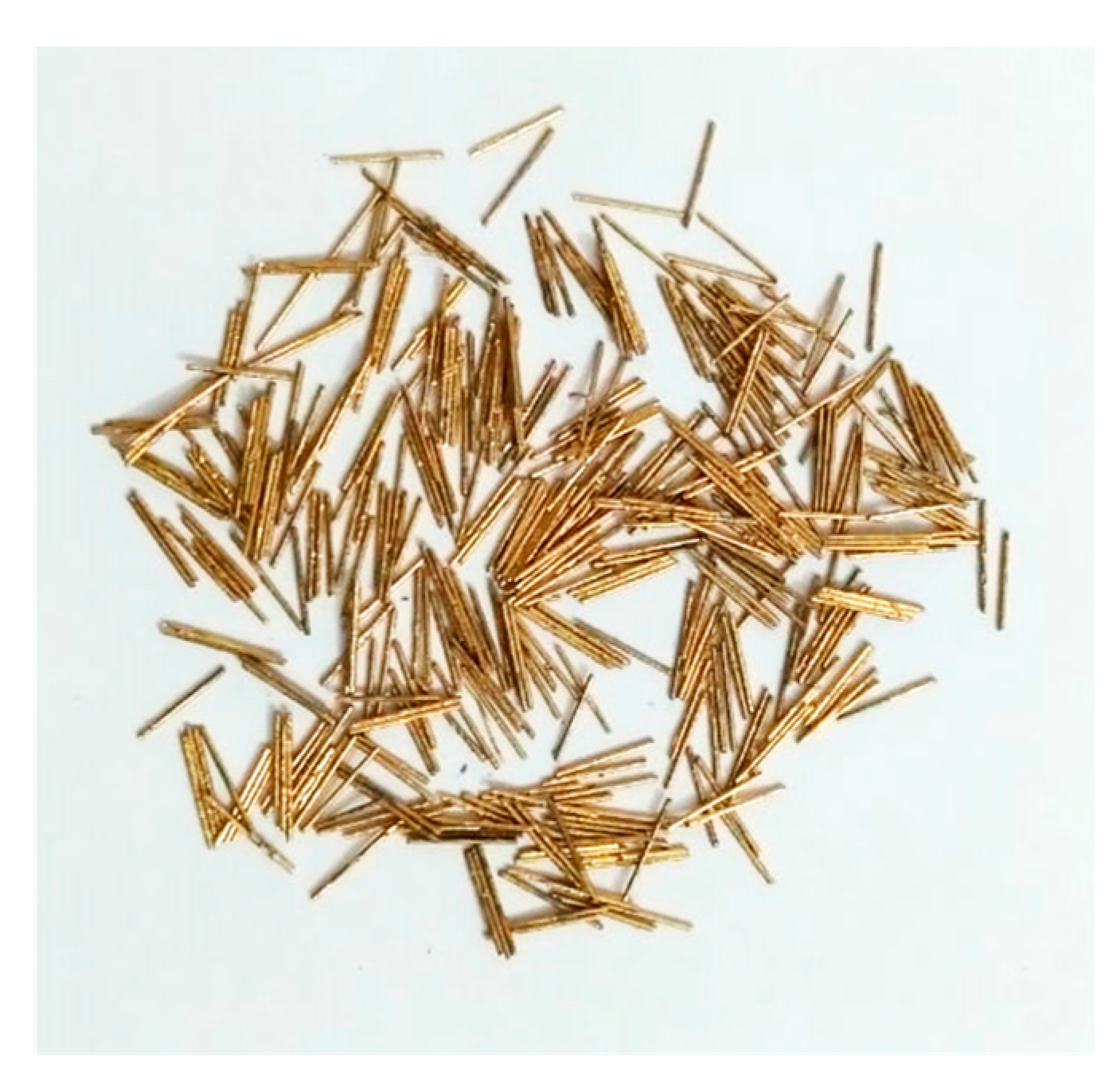
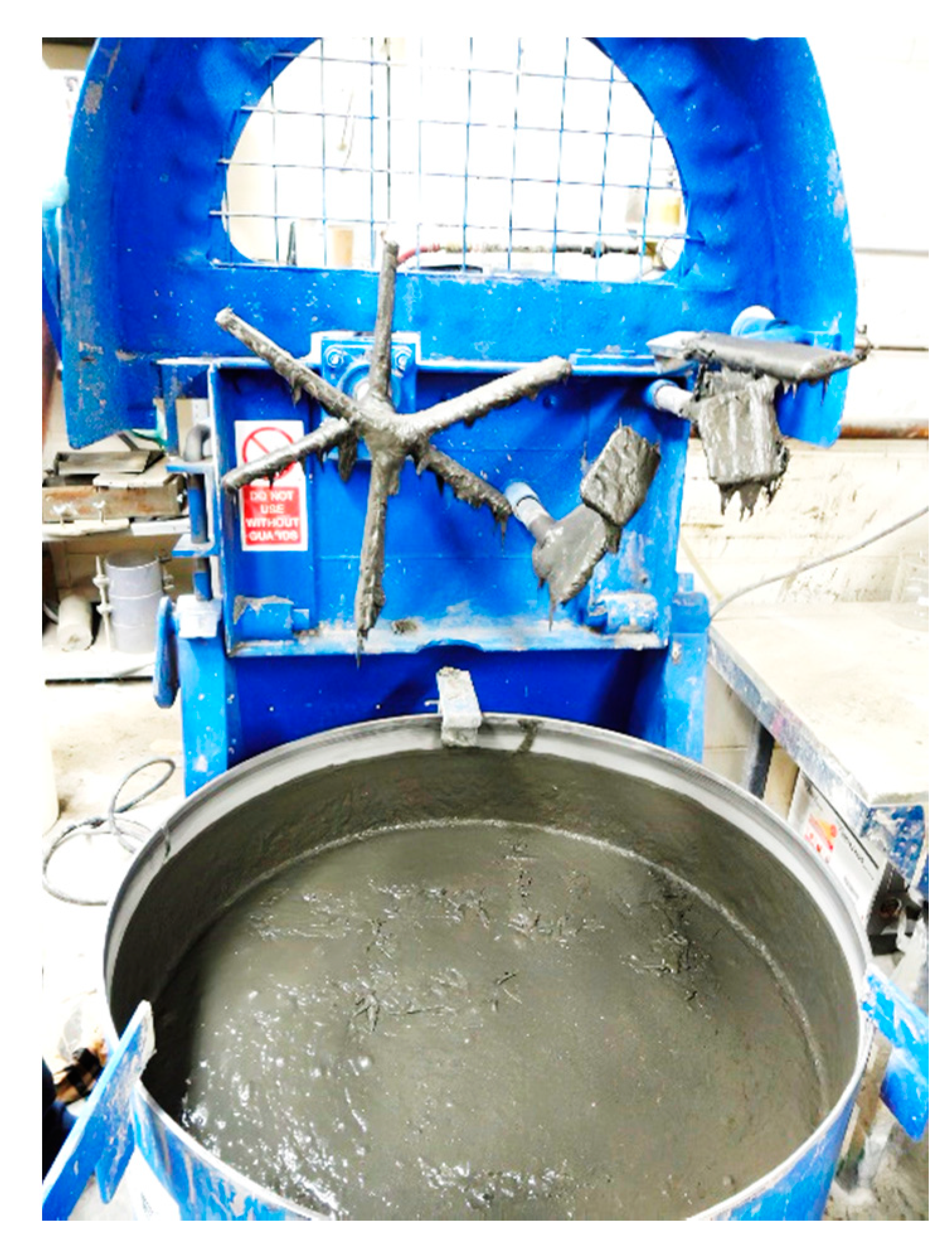
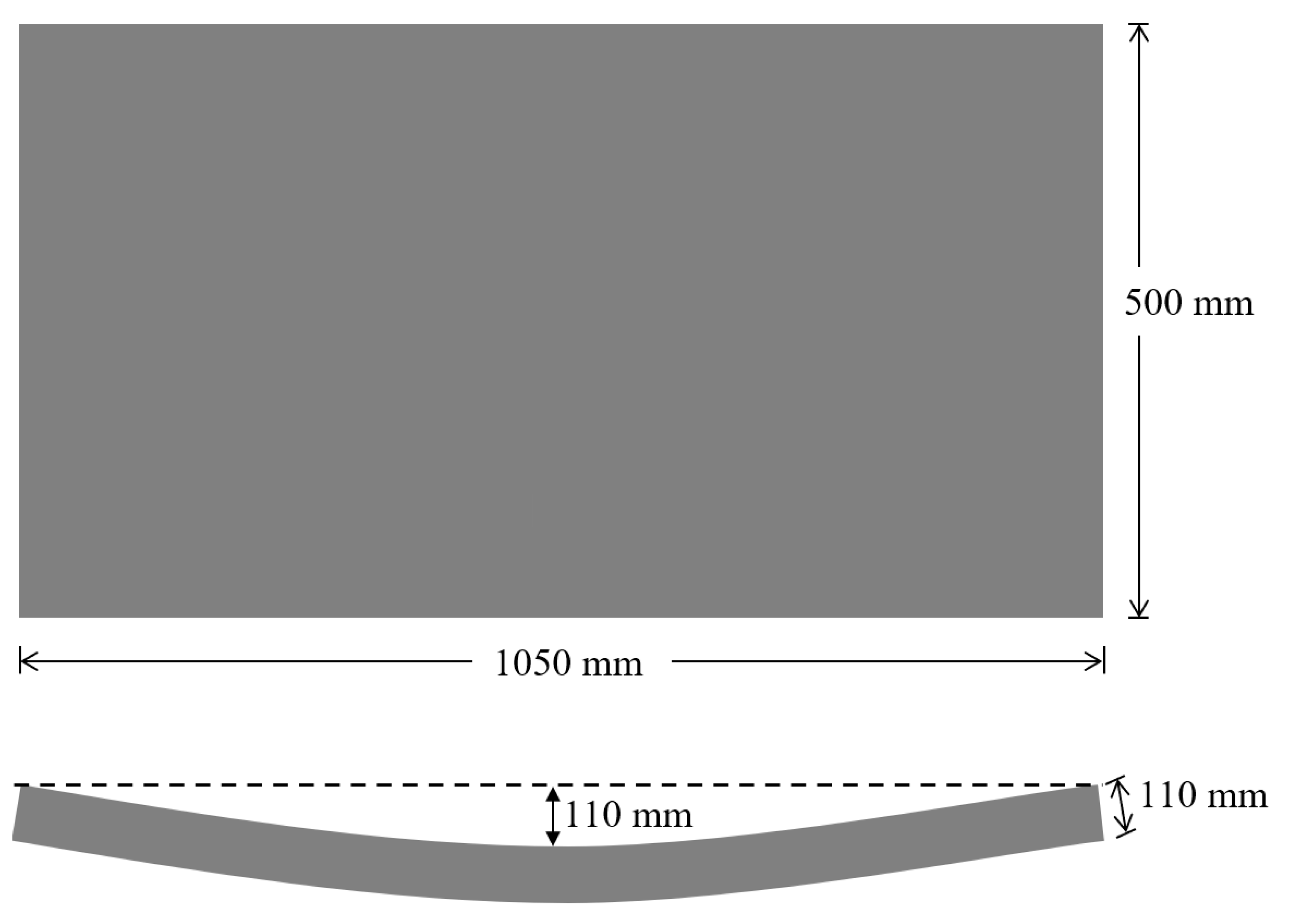
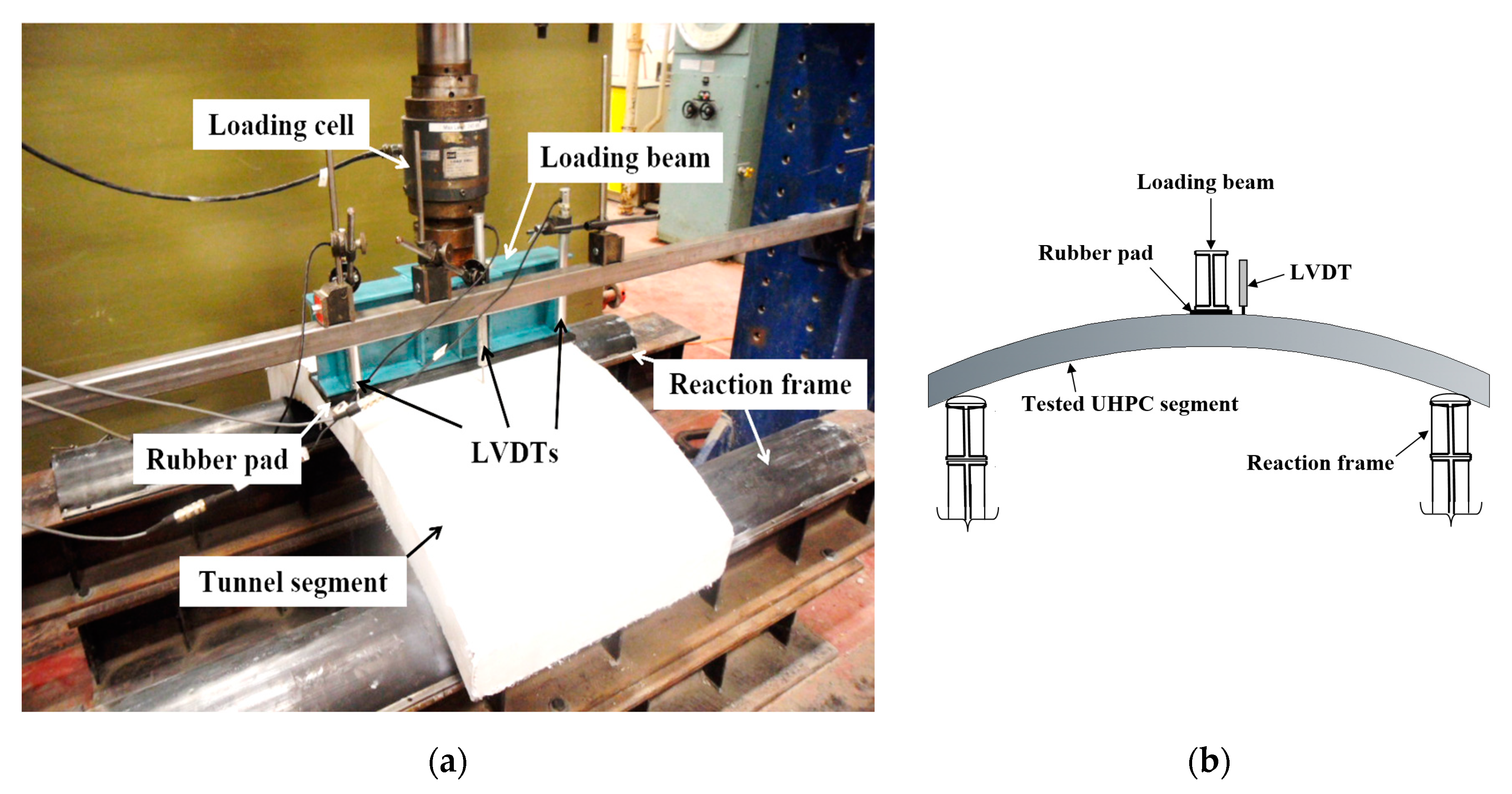

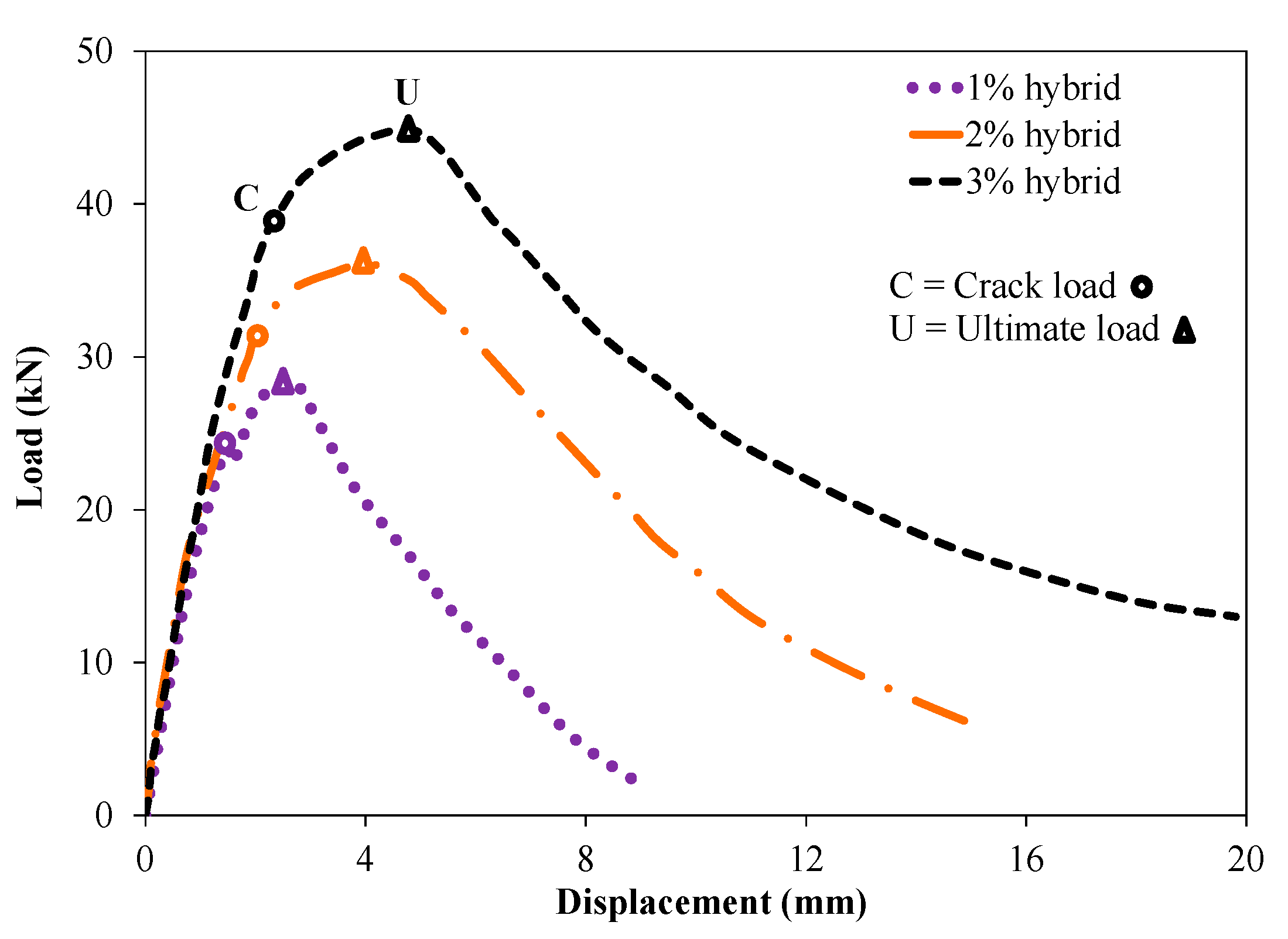
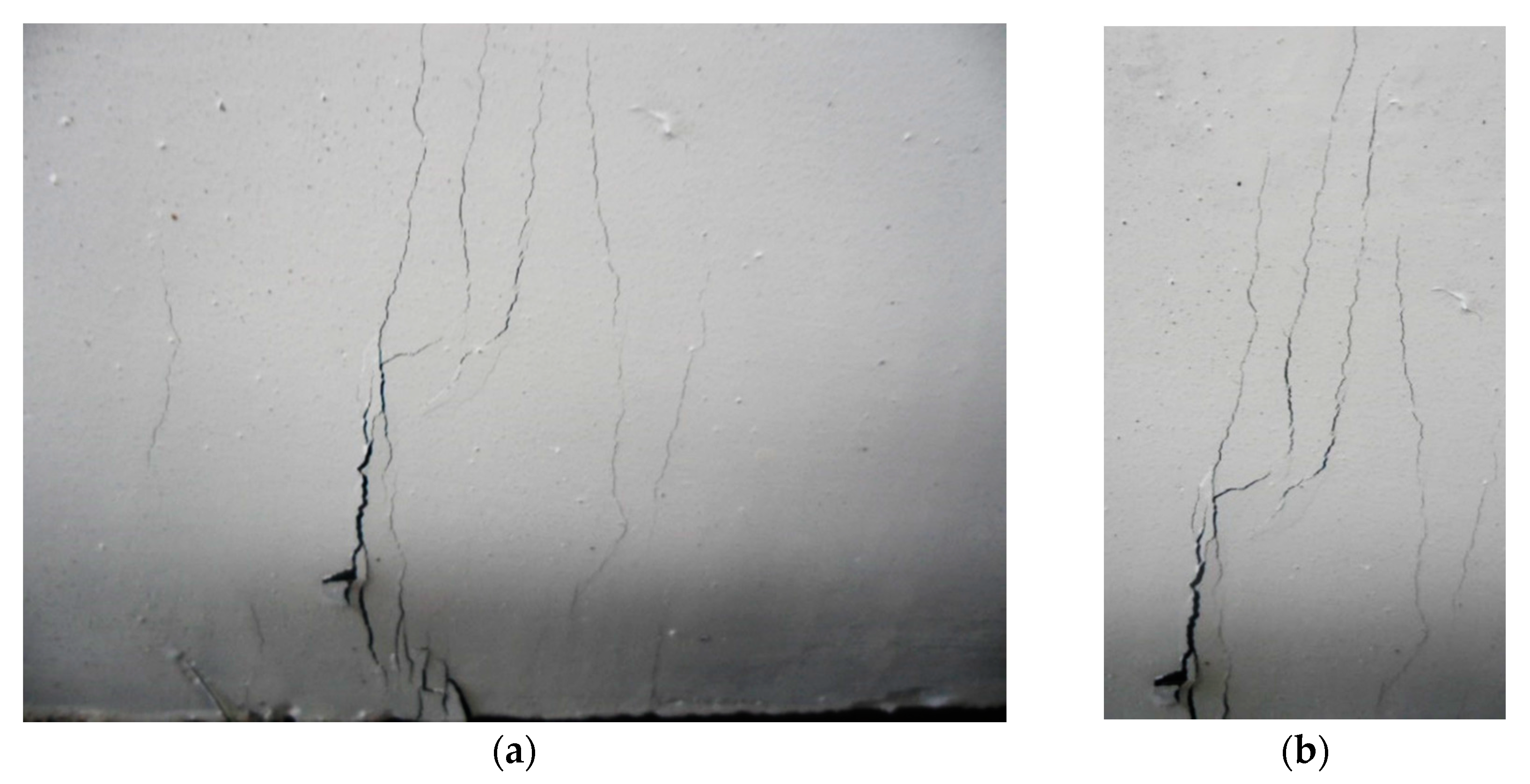


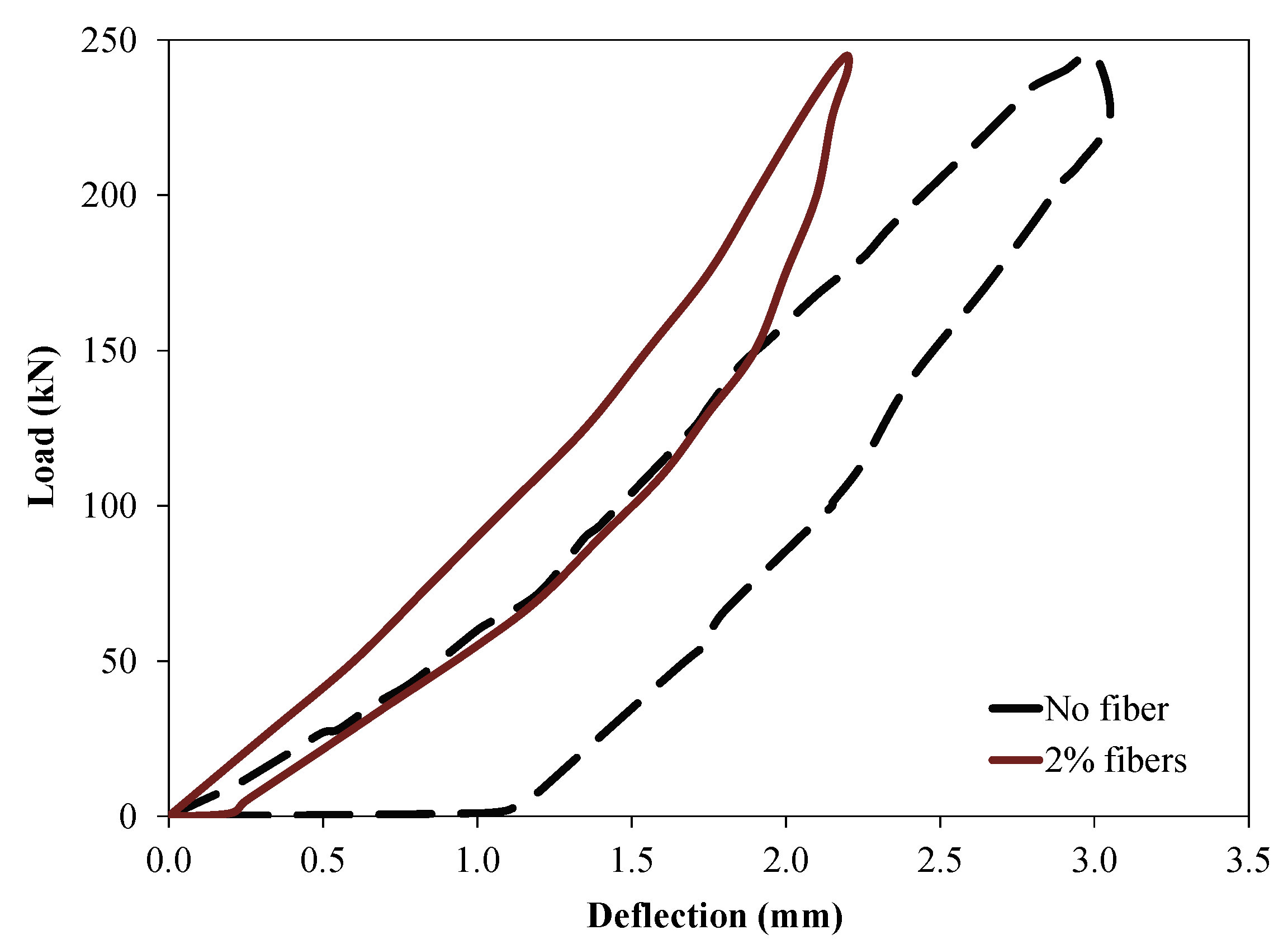
| Components | Cement (%) | Silica Fume (%) | Quartz Powder (%) | Quartz Sand (%) |
|---|---|---|---|---|
| CaO | 62.51 | 0.50 | 0.01 | 0.01 |
| Al2O3 | 3.80 | 0.15 | 0.06 | 0.04 |
| Fe2O3 | 3.62 | 0.09 | 0.03 | 0.04 |
| SiO2 | 19.31 | 95.40 | >99 | > 99 |
| MgO | 2.64 | 0.37 | - | - |
| SO3 | 3.93 | 0.20 | - | - |
| K2O | 1.12 | 0.52 | - | - |
| Na2O | 0.15 | 0.18 | - | - |
| LOI | 1.81 | 1.87 | 0.11 | 0.13 |
| Materials | Ratio of Cement Mass |
|---|---|
| Cement 1 | 1.00 |
| Silica fume | 0.25 |
| Quartz powder | 0.25 |
| Quartz sand | 1.25 |
| Water | 0.25 |
| Superplasticizer 2 | 2.50 |
| Test | Number of Specimens | Coefficient of Variance for Various Fiber Dosages | |||
|---|---|---|---|---|---|
| 0 | 1% | 2% | 3% | ||
| Flowability | 4 | 2.10 | 2.05 | 2.22 | 1.85 |
| Compressive strength (75 mm × 150 mm) | 5 | 1.44 | 1.20 | 1.52 | 2.06 |
| Tensile strength (75mm × 150 mm) | 5 | 1.71 | 1.54 | 2.11 | 2.17 |
| VPV (75 mm × 150 mm) | 5 | 1.65 | 2.23 | 2.17 | 1.88 |
| Sorptivity test (75 mm × 150 mm) | 5 | 1.82 | 2.12 | 1.56 | 1.89 |
| RCPT (75 mm × 150 mm) | 5 | 2.11 | 2.51 | 1.87 | 1.60 |
| Fiber Dosage (%) | Flow Diameter (mm) | Compressive Strength (MPa) | Modulus of Elasticity (GPa) | Tensile Strength (MPa) |
|---|---|---|---|---|
| 0 | 810 | 148 | 39.6 | 9.50 |
| 1 | 792 | 157 | 39.8 | 15.80 |
| 2 | 773 | 160 | 40.2 | 18.02 |
| 3 | 752 | 164 | 40.8 | 21.52 |
| Fiber Dosage (%) | VPV (%) | Sorptivity (kg/m2/h0.5) | RCPT (Coulombs) |
|---|---|---|---|
| 0 | 3.51 | 0.0430 | 70 |
| 1 | 3.27 | 0.0386 | 62 |
| 2 | 3.15 | 0.0348 | 54 |
| 3 | 3.01 | 0.0313 | 46 |
| Fiber Dosage (%) | Crack Load (kN) | Ultimate Load (kN) |
|---|---|---|
| 0 | 18.10 | 18.65 |
| 1 | 25.55 | 28.50 |
| 2 | 31.55 | 36.20 |
| 3 | 39.15 | 44.80 |
Publisher’s Note: MDPI stays neutral with regard to jurisdictional claims in published maps and institutional affiliations. |
© 2021 by the authors. Licensee MDPI, Basel, Switzerland. This article is an open access article distributed under the terms and conditions of the Creative Commons Attribution (CC BY) license (https://creativecommons.org/licenses/by/4.0/).
Share and Cite
Abbas, S.; Nehdi, M.L. Mechanical Behavior of Ultrahigh-Performance Concrete Tunnel Lining Segments. Materials 2021, 14, 2378. https://doi.org/10.3390/ma14092378
Abbas S, Nehdi ML. Mechanical Behavior of Ultrahigh-Performance Concrete Tunnel Lining Segments. Materials. 2021; 14(9):2378. https://doi.org/10.3390/ma14092378
Chicago/Turabian StyleAbbas, Safeer, and Moncef L. Nehdi. 2021. "Mechanical Behavior of Ultrahigh-Performance Concrete Tunnel Lining Segments" Materials 14, no. 9: 2378. https://doi.org/10.3390/ma14092378
APA StyleAbbas, S., & Nehdi, M. L. (2021). Mechanical Behavior of Ultrahigh-Performance Concrete Tunnel Lining Segments. Materials, 14(9), 2378. https://doi.org/10.3390/ma14092378







